AdventureSmith Explorations’ Aaron Gaines reviews his 8-day Beluga Galapagos Cruise.
In this review I will attempt to recount my recent Galapagos Islands experience without invoking clichéd terms such as: enchanted, magical, surreal, charmed, bucket list, exotic, amazing, sacred, life-changing, other-worldly, fantasy, mind-blowing. It will not be easy.
Yes, it is hard to describe these islands without resorting to grand statements, such are the delights that one encounters there. But describe them I must, in hopes of encouraging more people to give themselves the gift of traveling there at some point in their lives. If you are reading this you already want to go, which is a great start. After all, if you are a science lover, the Galapagos is the cathedral to which you must make a pilgrimage. If you are an evolution nerd, or a geology nerd, or a snorkel nerd… actually most types of nerds, this writer included, need no special invitation to visit Galapagos. Without further qualification:

Using the historic Andean city of Quito, Ecuador, as my starting point, I traveled to the Galapagos Islands for an 8-day cruise aboard the 16-passenger motor yacht Beluga. I chose this vessel because it is the boat I’d have picked for my own family’s vacation: moderately priced, air-conditioned but not fancy and small. The Beluga’s “Fernandina” itinerary appealed to me because of the focus on the Western and Central Islands, as their cold, nutrient-rich currents are host to the widest variety of marine life including whales, rare Galapagos penguins and dolphins. Traveling in mid-September as the garua season concluded, despite the still-warm air (average high of 76 F, average low of 62 F), I knew to expect some wind chop on the seas, foggy mornings on the Western Islands leading to sunny afternoons, and cold water for snorkeling.
Day 1 – Santa Cruz Island & Getting to Know the Beluga
I began in Quito and took a private transfer to the airport where my English-speaking guide helped me to check in quickly (this service is included in AdventureSmith’s Galapagos Cruise Package). After a short flight to the coastal city of Guayaquil to pick up more travelers we flew 1h 40m to Baltra airport. I met the Beluga’s naturalist guide, Juan, and 15 traveling companions, and boarded a minibus for the lush highlands of Santa Cruz Island. There, after only being in the Galapagos for about an hour, one of my life-long dreams came true. On private pastureland ringed by misty forests, we wandered a green field peppered with giant land tortoises. I walked over to one and spent about 40 minutes quietly watching as it munched on the low-lying vegetation. To be in the close presence of a living dinosaur is compelling. I loved the ghostly sound of the tortoise’s breathing as the air exited its circular bone nostrils. We ate a sack lunch on a patio overlooking the field and then drove south to Puerto Ayora to meet the Beluga. Along the way, we passed tall groves of woody daisy trees, which are a variety of Scalesia endemic to the Islands.
Puerto Ayora is a small fishing town that also hosts the Charles Darwin Research Station’s tortoise breeding program. Formerly the home of Lonesome George (R.I.P., George), the station is a series of pens and enclosures, some containing bales of baby tortoises and others holding adult former pets that were seized and repatriated to the Center. Some of the former pets are well over 100 years old! Speaking of the adults, it is educational to view several individual species side by side and to note the differences in shell shape and neck length which evolved due to each island’s respective vegetation types. Several species of finches flutter around the campus, and a few pens also hold large land iguanas.
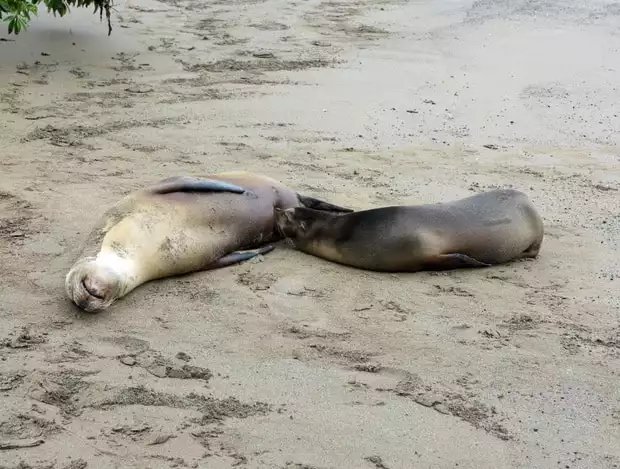
Wandering down the humble main street in late afternoon, I pass the begging pelicans at the small fish market and join a crowd of spectators at a volleyball court. As the sun sets I meet up with the group at the marina and board the Beluga, our home for the week.
Beluga is a handsome 16-passenger motor yacht that is known to be the fastest small ship in the archipelago. Guest cabins occupy the downstairs, and a dining room, bar and lounge area fill the main deck behind the bridge. A partially covered sun deck takes up most of the top deck. The ship’s bow and the fore section of the top deck can be used as observation areas, though all of the cushy seats are located on the larger sun deck. The cabins below have portholes, small closets and private bathrooms. There are two cabins to the aft of the main deck that have large back-facing windows, and doors that open to the lounge. The top deck has one cabin whose door opens to the sun deck. The small size of the cabins is no problem: simply put, this is a ship where guests adjust to the typical trappings of boat life, rather than having the feeling that they’ve boarded a floating hotel. Neither the cabins nor the public spaces on the Beluga are appointed in a fancy way, but are all clean, comfortable and pleasant. Sitting at one of the two eight-person dinner tables, one feels like a guest at a bed & breakfast.An eventful Day 1 concludes at anchor in the Puerto Ayora marina with the guests becoming acquainted over a meal of chicken, rice and vegetables.
Day 2 – Floreana Island & Devil’s Crown
We awaken near Punta Cormorant on Floreana Island. We eat eggs and toast under a cloudy sky with occasional light rain and intermittent sun. We skiff to a beach and walk among a few dozen sleepy sea lions. A few are playing in the surf and a baby bellows from a rocky perch. We pass beyond the beach and follow a trail to a series of lagoons where we spot a handful of very bright pink flamingos feeding in the shallow water. This is a delight for all the guests. We walk farther across the narrow point until we reach a classic white-sand beach on the other side. Low dunes at the rear of the beach reveal signs of sea turtle nests, and flame-colored Sally Lightfoot crabs dance across jet-black lava rocks near the surf.
The impression left on a visitor like myself is that this is the most alive place I’ve ever been.
Soon we are back on the ship and preparing for our first snorkel of the trip. We take pangas to the well-known Devil’s Crown rock formation a short distance away, and kerplunk, we are snorkeling. The water is very cold and thanks to our wetsuits we have about 40 minutes before our bodies demand a hot shower. Under the watchful eye of the ship’s crew we split up and explore the nooks and crannies of this dramatic outcropping. Spiny green and black sea urchins dominate the underwater rocks, and numerous fish species swirl past. I manage to spy the twitch of an octopus on the sandy bottom, and several of my companions see a small white-tipped shark.
Before the day ends we have mailed postcards from Post Office Bay, explored a lava tube and huge underground chamber, giggled at the discovery of pair of free-loading sea lions lounging on the Beluga’s swim deck and enjoyed a nice dinner.
Day 3 – Puerto Villamil, Isabela Island
Day 3 dawns in the turquoise waters of Puerto Villamil harbor on southern Isabela Island. We spend our morning outside of town hiking up the side of the Sierra Negra shield volcano. Thick clouds prevent us from viewing the vast crater, but we amuse ourselves with conversation and efforts to spot new bird species among the vegetation. Back at the harbor in the sun, I photograph the pastel-painted fishing boats and sea lions that snooze on the docks as local fishermen clean and stock their small vessels. In the afternoon we walk independently around town and visit a small brackish lagoon area to search for flamingos. I meet several of my shipmates at a beachfront café to drink from fresh coconuts (with a splash of rum). The night brings a wavy traverse around the southern end of Isabela, and we begin a part of the Galapagos trip that I’ve been looking forward to very much.
Day 4 – Punto Moreno & Elizabeth Bay, Isabela Island
Our group of 16 has really begun to bond, and breakfast is filled of chatter and excitement as Day 4 begins. At Isabela’s Punto Moreno, we walk a stark volcanic landscape of ‘A’a and Pahoehoe lava. It is strong yet brittle and very noisy to step on. On this young piece of a still-forming island, only the pioneer flora has arrived, and no soils have had a chance to cover the land. As we walk we encounter small ponds that contain fish, sharks, flamingos and ducks. The clear morning affords us views of nearby Cerra Azul and yesterday’s now-faraway Sierra Negra.

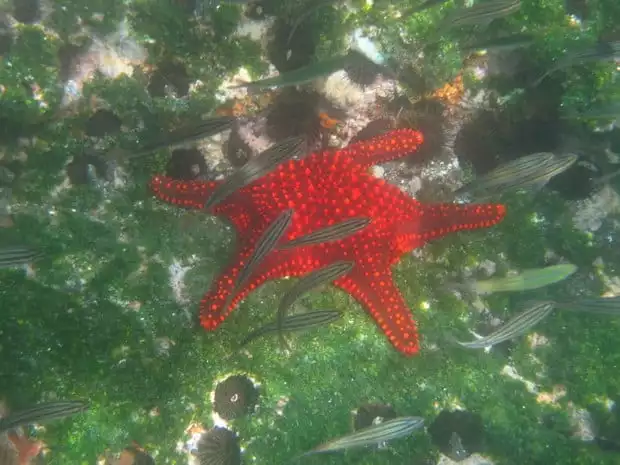
By mid-day the garua mists have cleared into full sun and we pull on our wetsuits for a snorkel. Out here on the west-facing side of Isabela the water is very cold indeed. Funny though, that just one glance underwater through my mask makes me forget about the chill as the undersea environment is absolutely jammed with life. Six-foot Pacific green sea turtles are everywhere here, munching on the greenery in the shallow water near where the waves spill onto rocks. Here, the various colorful fish have no chance of getting my attention as I am transfixed by dozens of turtles. Eventually, I am pulled away when a juvenile sea lion begins to playfully dart around members of our group. Showing off, he comes to a stop and contorts his body, upside down and with perfect neutral buoyancy, like a statue. He exudes a childlike glee and I cannot help but anthropomorphize a bit: “Didya see me? Didya see me? Huh? Didya?!” When he finally zips away I follow a flightless cormorant on a dive toward a small school of fish. Then, back to the sea turtles. Surfacing to adjust my mask, I notice pelicans floating lazily just 10 feet away. This time flies by and soon I am chilled to the core, needing to get dry and warm… but the time snorkeling among the Galapagos Islands animals here was pure joy for me.
In early afternoon Beluga motors north along the coast toward Elizabeth Bay, and from the sun deck we see rafts of hundreds of shearwaters. Sea lions leap in the ship’s wake while frigate birds ride the airwake, and big Manta rays occasionally leap from the water beside the boat. The impression left on a visitor like myself is that this is the most aliveplace I’ve ever been.

Nearing Elizabeth Bay, the ship slows and adjusts course as the Captain spots two Minke whales. Later, a Bryde’s whale passes the ship. They aren’t highly active – just cruising – but the guests remain on deck for well over an hour as the boat traces the big animals’ movement. Then, we cruise into the calm waters of Elizabeth Bay and anchor: nap time. At 4pm I awake and board a panga with my companions to explore the complex mangrove forests that occupy the innermost reach of the Bay. I am immediately aware that I am entering a peaceful place. Our panga driver Raul turns off our motor and uses a paddle to drive the raft from now on. Here, among narrow canals and the dramatic roots and branches of the mangroves, is a nursery for baby sea turtles and rays. Platoons of spotted and cow-nosed rays gracefully pass by, and countless young turtles lift their heads to breathe. A grumpy-looking lava heron gives us a harsh look. Juan draws our attention to a mangrove tree and we take turns peeking between the leaves to view a huge sea lion taking a rest among the roots, his body completely out of the water (a “tree lion”). All guests are quiet as we exit the mangrove in the sunset, and I have the impression that we are each processing the experience of visiting this sacred spot. This meditative mood continues through dinner and into the night as I join several others to watch the crystal-clear Milky Way and drink a few beers.

Day 5 – Urbina Bay & Tagus Cove, Isabela Island
Beluga’s motor roars to life at 5:30am on Day 5and the ship heads north with an entourage of frigate birds. At Urbina Bay we land on shore for a walk, passing the fresh flipper-prints of newly hatched sea turtles headed from their sandy nests to the sea. Soon we encounter land tortoises, 3-ft long land iguanas and Galapagos hawks. The paths we walk also seem to be convenient travelways for the animals, and we happily defer to the tortoises as they shuffle by. A ways farther inland, we reach a bizarre scene: a stretch of beach with shells, barnacled rocks and sun-bleached coral skeletons, with no water in sight. As Juan explains, a 1950s earthquake lifted this once-shoreline area directly upward about 25 feet as the island’s footprint was suddenly remade. Back at the beach a few of us swim to relieve the heat, and we laugh as we are joined by a curious sea lion. On the ship most all of us take turns leaping from the ship’s top deck into the water. By this point in the trip, our group is no longer 14 adults and 2 children but 16 children playing and laughing and sharing new experiences. This is the power of these islands, where the human visitors are the strangest animals around.
This is the power of these islands, where the human visitors are the strangest animals around.
The Bolivar Channel is the north/south waterway between the islands of Fernandina and Isabela and is known for prime animal-viewing. The waters here are the recipient of the cold, nutrient-rich upwelling of the Cromwell undercurrent and provide an unusually supportive habitat for marine life. We motor up this stretch of water in the midday sun and I occupy myself by spotting now familiar creatures such as Manta rays, sea lions, frigate birds, pelicans and turtles. Crowds of seabirds dive on schools of fish as the shield volcano that is Fernandina Island looms in the haze to the west. The Beluga then pulls into Isabela’s tiny Tagus Cove, just as Darwin’s HMS Beagle did almost 178 years ago, nearly to the day (Sept 30, 1835).
After lunch and a quick nap, I suit up for a snorkel along the rim of the cove. As guests gather to exit the ship, we notice that our way to the stairway is blocked by a curious sea lion (who has jumped from the water onto the steps and climbed up them). We have to block her from coming all the way inside the boat, and she resigns herself to about 20 minutes of barks, contortions and gestures, all of which delight those gathered around. She is called away by a second sea lion who appears by the steps, and she waddles down awkwardly before slipping into the water and gracefully gliding away. We then smoothly descend the stairs before awkwardly splashing around the water in our flippers!
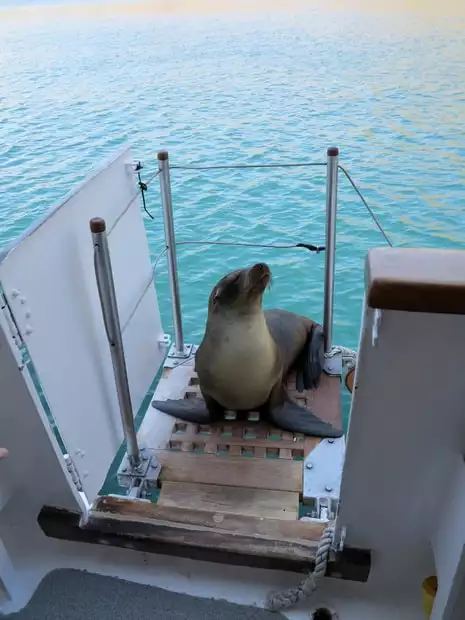
I snorkel along the vertical wall of the cove, and sunlight illuminates the first 20 feet or so before the water beneath me becomes too dark to see into. The wall is covered in many creatures, and I enjoy seeing a large pink Pacific conch and several colorful pufferfish. Urchins and sea stars are everywhere, along with sea lettuces and corals. I try and fail to photograph the speedy flightless cormorants and Galapagos penguins that zip by me in pursuit of fish.
Quickly, we switch clothing and re-board the pangas for a trip to shore. On the rock faces near our landing site are the scrawled and carved names and dates left by voyagers from the past. There, we walk through sparse volcanic landscapes up to Darwin’s “lake” and a view of Volcan Darwin. Before dinner the guests share cocktail hour on the top deck as the Milky Way comes into pinpoint focus. All of the fresh air, cold water and hot sun have combined to equal an early bedtime for all.
Day 6 – Fernandina Island & Punta Vicente Roca on Isabela
After a breakfast of bacon, eggs and toast, we motor the short distance across the channel to the only landing site on Fernandina Island, Punta Espinoza. This young island is quite bare of vegetation, though mangroves grow by the sea and some pioneer species are making headway. Rather than vegetation, it is marine iguanas that cover this area, by the many hundreds. These bizarre-looking creatures are spending the morning warming up on the rocks before heading to the cold waters to feed. A spitting sound can be heard as the animals eject salt from a unique orifice on their faces. Joining the iguanas are lava lizards, Sally Lightfoot crabs, hawks, pelicans and cormorants. This area seems to hold many sea lions with pups, as though it is a nursery or maternity ward. We even see a sea lioness in (what we suspect is) the early stages of labor, just feet away from us.
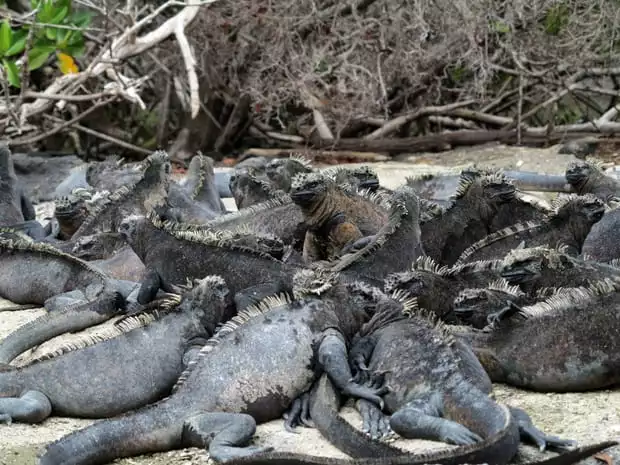
Later in the morning we snorkel at Punta Espinoza in an undulating underwater landscape of lava rock. In these shallow waters the sunlight penetrates everywhere and I have wonderful opportunities to spot creatures from a good distance. The complex contours of rock hold innumerable sea urchins and anemones. In narrow areas I must navigate around sea turtles. The sighting I prize most is the marine iguana, and it doesn’t take me long to see several swimming on the surface and then diving to feed on plants. The strangeness and beauty of the marine iguana is best appreciated when watching one operate underwater. I become isolated from the group but am soon met by an energetic juvenile sea lion. He spends 6 or 7 minutes buzzing around me, often in fast circles, and seemingly beckons me to “come on, follow me, I’ll show you around!” I have this interaction all to myself and I selfishly soak in the fun of it.
Just across the Bolivar Channel we find Punta Vicente Roca, our next stop. Here, we are tucked just under the ”nose” of the seahorse shape that is Isabela Island. The water is deep, and steep volcanic cliffs rise straight out of the sea. In this dramatic setting, we plop out of the pangas to snorkel in the cold waters on the edge of the protected cove while the crashing swells of the open Pacific are just a few hundred meters away on the other side. Juan advises us to stay close to the cove wall and to keep eyes open for large animals such as the mola-mola (Pacific sunfish) which can grow to weigh 5,000 pounds. I quickly seek out shallower water (with better visibility) and am delighted with what I discover there. Sea lions and Galapagos penguins are feeding on the many clusters of small fish in a boulder-filled zone toward the inner cove. As I kick my flippers and move toward the inner part of the cove, the bottom becomes sandy and sea turtles appear in all directions. Large turtles are resting in the sand, and others slowly swim by. There is a mellow feeling here, and I realize that I am visiting a popular rest-stop for turtles who’ve been navigating the open ocean currents.
Soon it is our time to head into the Pacific, and the Beluga pulls anchor and motors around the northern reach of the island. In doing this, we pass the equator and are invited onto the bridge to watch the navigation instruments read 00.00’00.0”. The novelty of this is fun but what is even better is the gorgeous sunset unfolding. I join the other guests on the sun deck for this, and we toast to the conclusion of a very special chapter of our adventure. All guests retire early as the seas are a bit rough, but by midnight we are anchored in the calm waters of Santiago Island’s James Bay.
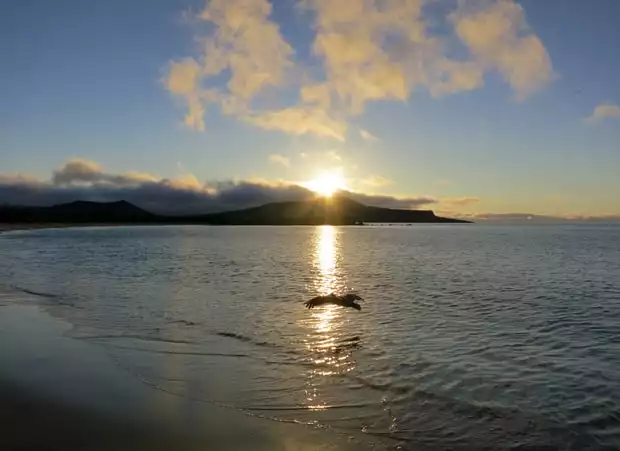
Day 7 – Santiago & Bartolome Islands
Day 7 finds a groggy bunch of travelers aboard the Beluga, and I sense that everyone may be exhaling a bit after an action-packed few days. We are now on the home stretch of our time in these islands. An extra cup of coffee does the trick, and soon I join my new friends on a panga to shore. We land at Puerto Egas to take a walk along the coast. I see American oystercatchers poke around tide pools, pelicans and blue-footed boobies dive for fish offshore, and marine iguanas sun themselves. Back at our landing site, we remain at the beach and switch into wetsuits for our last snorkel of the trip. We waddle into the water and start to kick our way around the nearby rocky point. I immediately spot a stingray and then a moment later, a white-tipped reef shark. Turtles and sea lions swim about, along with many species of fish. I see a large spotted eagle-ray slowly flapping its wings directly below me. The snorkel trip is brief due to the cold water, but I am happy to have seen several new animals before the trip ends.
We spend the middle of the day crossing the north side of Santiago on our way to Bartolome Island. Anchored there, the ocean view to the east is cluttered with several of the small Galapagos Islands (Plazas, Chinese Hat, Daphnes). We spot Bartolome’s distinctive Pinnacle Rock. Santiago is still very close, too: someday fresh lava flows will connect these two islands. Bartolome itself is a fairly barren moonscape of interesting rock formations. Walking, we can look back at the water and see Manta rays jumping. We also explore the edges of the island by panga and see several penguins. Soon enough the sun is setting, the Beluga is motoring toward N. Seymour Island and the guests enjoy a few beers up top. Before darkness arrives we spot a pod of fifty or sixty dolphins leaping from the water behind us. At dinner, Juan brings out his guitar to serenade a guest named Valeria for her birthday, and the chef presents a large birthday cake. The guests laugh with delight as he playfully sings several love songs in Spanish.
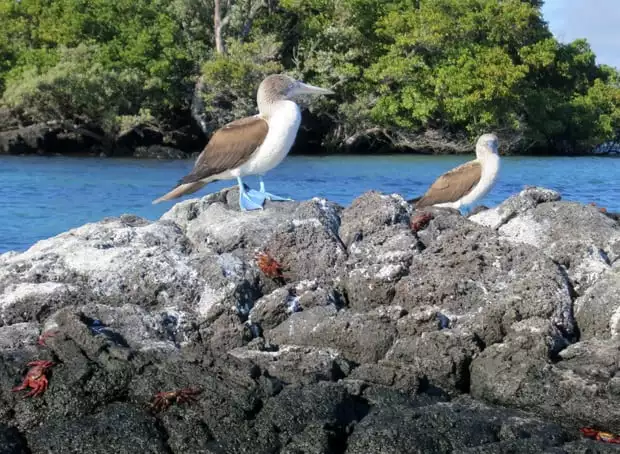
Day 8 – North Seymour Island
Day 8 is the end, but not before one last early-morning excursion. Before breakfast we head to a landing site where several bird species nest in large numbers. Walking the trails, we see fluffy white booby chicks and courting frigate bird pairs. Male frigate birds puff up their distinctive red gular pouches. The big nests are suspended on the bare trees 5 or 6 feet from the ground, and white bird droppings seem to cover every rock in sight. I spot several spiny cacti that smaller birds have burrowed into for nesting purposes.
We eat one last morning meal aboard Beluga and are dropped off at the dock at Baltra. Zoom, I am returned to the mainland, like waking up from a dream.
MORE GALAPAGOS RESOURCES:
Galapagos Cruises
Galapagos Cruise Deals
Galapagos Islands Yacht Charters
Galapagos Luxury Cruises
Galapagos Family Cruises
Galapagos Diving
How to Choose the Best Galapagos Cruise
Galapagos Island Hopping or Cruise?
Best Time to Visit Galapagos
How to Get to Galapagos
Galapagos Islands Animals
Galapagos Trips
Galapagos Tours
Galapagos Cruise Reviews
Galapagos Travel Guide
This Galapagos small ship cruise review was written by an AdventureSmith Explorations crew member. The Beluga is perfect for a full boat charter, read more about Galapagos yacht charters. Or contact one of our Adventure Specialists to learn more about these small ship cruises and wilderness adventures: 1-800-728-2875.
Comments will be moderated and will appear after they have been approved.